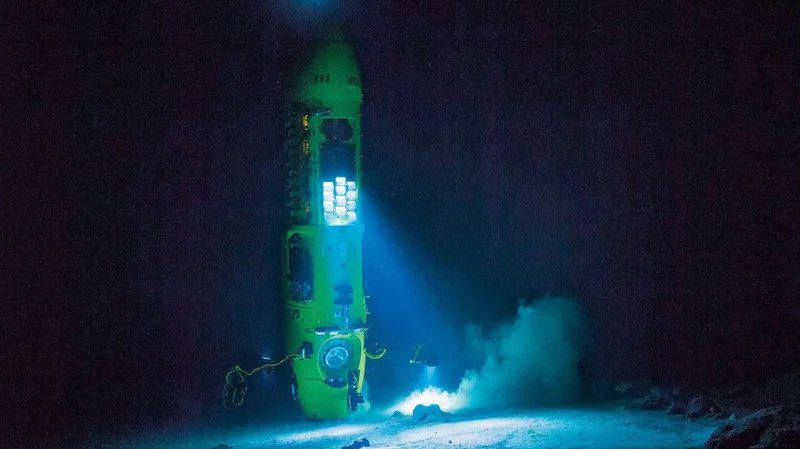You saw it on the news.
OceanGate’s Titan lost contact with its surface ship on the 18th of June, 2023.
The company was organizing touristic visits to the wreckage of Titanic for a “Titanic experience.”
A few days later the search and rescue teams found Titan’s wreckage.
A tragic ending.
People speculated about what caused the implosion.
Was it the carbon-fiber hull?
Was it the titanium structure?
Or was it something else?
We don’t know the answer yet, and maybe we’ll never know.
But let’s talk about another submersible with a much harder mission than Titan’s.
Deepsea Challenger.
And its pilot was somebody familiar: Titanic movie director James Cameron.
Besides making an unforgettable movie about Titanic, Cameron was also obsessed with the ship — like OceanGate’s founder.
He dived to see Titanic 30+ times.
He says he spent more time on Titanic than its captain.
But with Deepsea Challenger, the challenge was bigger.
They planned to go to the deepest place in the ocean —Mariana Trench— and stay there for hours to observe life.
Thanks to the news, now we all know how hard it is to make a successful visit to Titanic.
Many things can go wrong because of extreme pressure.
So here’s the thing.
The Titanic is 12,500 feet deep.
Mariana Trench is three times deeper — 36,000 feet (about 11 km).
Even creatures that live there are evolved to have no bones — as bones get crushed under pressure.
So how did James Cameron achieve this almost impossible mission with Deepsea Challenger and come back up safely?

Cameron worked closely with engineers for 7 years to design Deepsea Challenger.
He says they took it like a space mission.
You can run all the tests above the ground.
But when a vehicle goes that deep, things will likely go wrong.
So they expected ‘unexpected’ failures at bone-crushing depths with no sunlight.
And they added extra redundancy to the critical systems and structure.
And guess what?
During the two hours and a half dive to Mariana Trench, things did go wrong.
Several systems stopped working.
And Cameron partially lost the ability to control the vehicle.
But Deepsea Challenger had enough redundancy for critical systems to go back to the surface safely.
It was designed to be ready for things going wrong.
And perhaps that’s why Titan failed, and Deepsea Challenger survived.
The Efficiency Illusion
Now, here’s the catch.
One factor in business has a similar impact as diving into the ocean with a submersible.
Time.
Time brings many unknown unknowns that are out of your control.
Every year that passes increases the risk of a major shock.
And in a long enough time, shocks become inevitable.
Like crises, pandemics, wars, regulation changes, or technology disruption…
Sure, some can also turn into lucky events for your business.
But if you don’t survive the negative shocks, nothing else matters.
And think about businesses today.
The modern world is built on efficiency.
One example is manufacturing companies.
They aim to have low inventories with systems like just-in-time.
So they keep inventory costs at the minimum.
And they make employees redundant to cut costs as soon as growth slows down.
Efficient, isn’t it?
It is indeed, but it brings a problem.
This approach assumes everything is predictable: customer demand, production capacity, raw material availability…
After all, their forecasters have the data from the past 5 years.
Well, Titan also had some successful dives in the past.
But life is like deep sea — it’s full of surprises.
A pandemic started after 100 years.
China went under lockdown.
Production facilities got closed.
Efficient companies with zero-to-low inventories ran out of products.
Just-in-time became nothing-in-time.
In parallel —as people spent more time at home— demand for certain products rose.
Like electronics, fitness equipment, and toilet paper…
On top of low inventories, most companies couldn’t keep up with demand as they didn’t have enough employees.
No products on the shelves = fewer products sold = less revenue.
So when the unexpected happened, the only companies that survived (and thrived) were the ones with redundancy.
The ones with higher inventories.
The ones who had production facilities and suppliers in different countries.
Or a workforce that could meet the demand spike.
And this redundancy gives them a huge opportunity and pricing power during crises.
Even though it’s less efficient.
If you remember how Nassim Taleb defined antifragility, it’s not about only resisting shocks.
But also to be in a position to gain from them.
So, how can you make your business antifragile with some redundancy?
Here are three ways:
1. Keep your bullets ready
Some famous investors say cash is trash.
Extra cash from profits should always be invested in different assets according to them.
But if unexpected shocks are certain given enough time, that’s like diving to see Titanic with no redundancy in your critical systems.
Eventually, something will go wrong.
And you won’t have a lifeline when everybody is looking for it.
Not the best idea.
So no matter how inefficient it is, always keep some extra cash or cash-like assets.
It will make you sleep better.
But it will also allow you to take advantage of unexpected opportunities.
An unexpected expense?
No problem.
A new opportunity to invest in?
You have the bullets ready.
Warren Buffett has kept a huge cash stockpile throughout his investment career for a reason.
2. Build multiple revenue streams
It’s in our nature.
When something works so well, we feel like it’s gonna work forever.
Having a successful product is like that.
Microsoft made this mistake with Windows.
And maybe Google has been doing it with search.
Now for a startup, it’s important to focus early on and put all the effort into a single point — remember Blitzkrieg.
But becoming successful and staying successful require different approaches.
Apple’s biggest weakness was —ironically— the huge success of the iPhone.
If iPhone sales went away for whatever reason one day, Apple would be screwed.
But Tim Cook was wise enough to recognize the risk before it happened.
And that’s why he has been diversifying revenue with services, wearables, and ads.
So focus until the initial success.
Diversify revenue streams after you get it.
What looks redundant today might keep your business alive in the future.
3. Beware of big customers (and partners)
Advertising legend David Ogilvy always advised against having “too big” clients relative to an agency’s size.
Why?
Because if one client represented the majority of the billings, losing that customer would disrupt the agency.
They’d become too dependent.
So they’d have to do everything they can to keep that client.
Like giving advice that will appease the key contacts.
Instead of saying what they really think.
Which would likely lead to bad advertising and lose that client anyway.
Now his wisdom not only applies to clients but also to partners.
Many businesses depend on a single traffic channel (Google-search, Meta-ads, etc.)
And many others depend on a single marketplace or an infrastructure partner.
Again, when everything is good; it feels like it will be good forever.
But their incentives might change one day.
Taleb has the best analogy to explain it.
The story goes like this.
One turkey makes a presentation to his fellow turkeys.
And he shows the historical data: their conditions got better and better every year with the butcher.
The butcher has been friendly to them, provided shelter, and gave them food.
So based on this historical data, he shows his forecast.
Next year they will get more food than ever from the butcher.
But a few months later Thanksgiving comes.
An “unexpected event” happens.
The forecaster turkey and his friends become Thanksgiving dinners.
Moral of the story?
Don’t let historical data or existing good conditions fool you.
Never over-rely on one friendly butcher.
Add alternatives before you need them to avoid becoming a turkey on Thanksgiving.
–
Found this article useful?
Enjoyed this article?
Then you’ll love the How Brands Win Newsletter.
Get the “5 Mental Models to Differentiate Your Business” guide when you join. It’s free.
